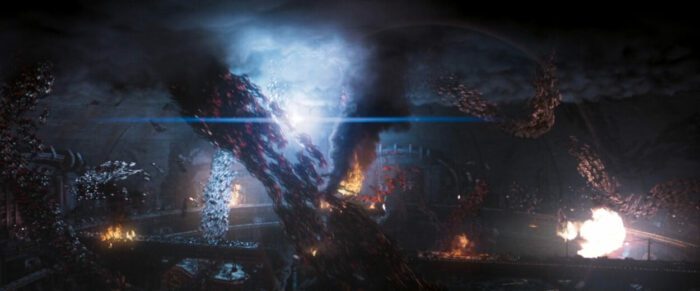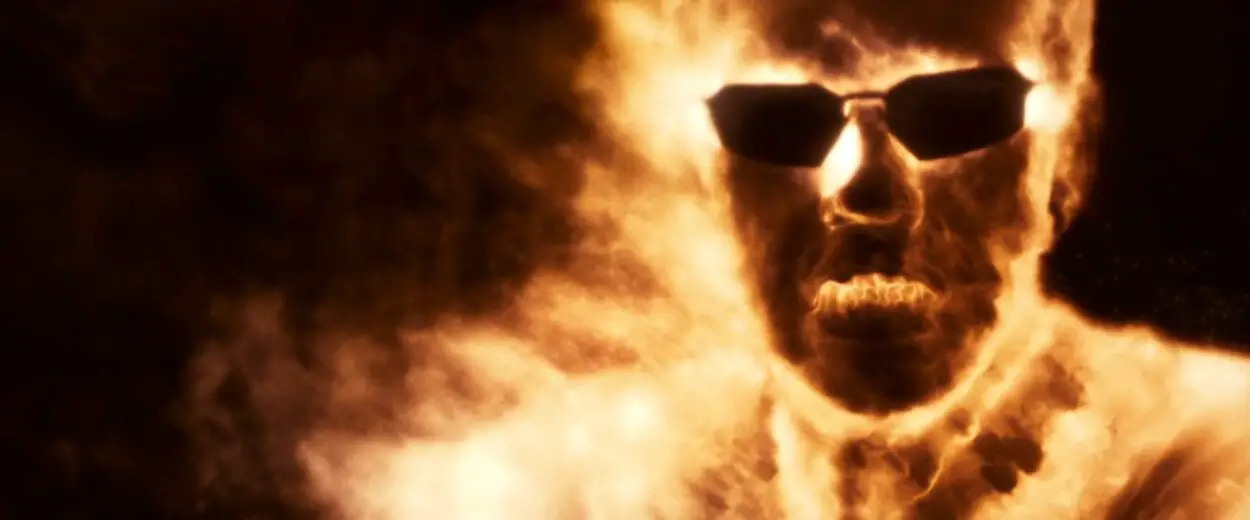Following months of speculation over what the third and (at the time) final Matrix film would do after the cliffhanger ending of The Matrix Reloaded in May, The Matrix Revolutions was released on November 5, 2003. While the previous entry in the series had its critics, it still managed solid reviews and made over $740 million at the box office. Revolutions fell short of that.
I remember exactly how I felt walking out of the theater that fall. It was a combination of admiration and feeling let down. There’s a lot that I love about The Matrix Revolutions, but I still feel it doesn’t pay off everything that came before it. Perhaps that’s the point. Whether it is or not, I’ll get to later, but for now, I want to talk about the stuff that blew me away then and that blows me away now.
Roger Ebert wrote that if he “was able to put aside [his] questions, forget logic, disregard continuity problems and immerse [himself] in the moment, “The Matrix Revolutions” [sic] is a terrific action achievement.” Fair enough. Now, I’ve never had any issues with following the logic of the Matrix trilogy, but Ebert’s right about the action. It’s kind of incredible.
The centerpiece of the film is the Battle of Zion, which is still impressive 20 years later. It’s not as epic as, say, Battle of the Pelennor Fields from The Lord of the Rings: The Return of the King from that same year, but it’s still big. Story-wise, we’re dealing with humankind’s last stand. That in and of itself has stakes, and though the characters are pretty thin, it’s nice that this entire sequence is not just anonymous faces.

However, it’s the visuals and the sound that elevate that stick with me the most. Yes, there’s a ton of CGI, but there’s also model work and sets. Honestly, there are stretches where I can’t tell the difference. This is my subjective point of view. Plenty of viewers most likely notice the CGI and get taken out of the film periodically. For me, I’m all in. I buy that entire sequence. Rewatching it recently on 4K, I’m amazed it still holds up. In fact, the only thing that takes me out of it is the dialogue, which, at times, is just flat, dull, or cheesy.
Now, I’m the guy who loved the Architect scene from The Matrix Reloaded, so I’m open to all kinds of dialogue, whether it be naturalistic or expository. However, there’s a real disconnect between seeing such fantastical images such as sentinels laying siege to Zion and then hearing an exchange like this:
ZEE: You scared, Charra?
CHARRA: Shit, yeah. I’ll make you a deal, though. You keep loadin’, I keep shootin’.
ZEE: Deal.
Still, it’s not a deal breaker.
The other impressive sequence has to be the climactic fight between Neo and Smith. The slow-motion close-up punch to Smith’s face isn’t the greatest effect, though, and it is odd that the showdown between the two comes down to, well, a fight. There’s kung fu and flying, but visually speaking there’s nothing all that epic about this showdown, not compared to the Battle of Zion. As I mentioned earlier, perhaps that’s the point.
It makes sense that the Battle of Zion is epic, given the amount of people and machines involved. In this fight, it’s only Neo and Smith. Now, sure, there is more than one Smith, and we know they can all fight thanks to The Matrix Reloaded. However, there’s an intimacy here that is important.
Neo is not only fighting Smith in this scene, but he’s also fighting the Oracle. Earlier in the film, Smith took over the Oracle so that he could have her power of foresight. With this knowledge, Smith is confident that he will not only beat Neo but also destroy the matrix. In a sense, this proves to be true once Neo stops fighting and allows Smith to win, which in turn allows the machines to reboot the matrix.
Figuratively speaking, Neo choosing to stop fighting Smith is really Neo choosing to stop fighting the Oracle, which is really just Neo choosing to stop fighting his destiny. The path of the One ends at the source and with the matrix being rebooted. Well, Neo goes to the machine city, in a way, the source of the matrix, and well, we know how it ends. So, then, why is the final fight between Neo and Smith just the two of them fighting?
It’s because The Matrix Revolutions is about acceptance. Smith accepts the end just as much as Neo does. We know this because of how tired he is at the film’s end. “Is it over?” he asks the Neo-version of himself who smiles knowingly. Morpheus, meanwhile, accepts the reality that sometimes a part of faith is acknowledging that it can come with lies. And Niobe accepts that perhaps there is some truth to be found in having faith. It makes sense that these two find each other again in this film because one has become less fundamentalist in his faith, while Niobe has opened herself up to it.
Of course, there’s the Oracle, who, by the film’s end, explains that she never had faith, that she “believed.” Why would she? She’s the Oracle. She knows where things are ultimately headed. There’s no need for faith when you know. As she tells Neo in The Matrix Reloaded, it’s not really about the decision one makes. One’s already made it. The important thing is to understand why and to accept. Once that happens, even when you know, this is when you can start to believe. And I like believing a lot more than faith. Then again, there’s a lot I don’t know.

Like the previous entry in the trilogy, there is a lot of philosophy in this film. Like I wrote last time, I can understand why audiences and critics could get tired of it or even find themselves rolling their eyes whenever this stuff comes up. For me, though, like most of the effects, I kind of love it. I’ll take the Oracle’s exchange with the Architect at the end of the film over most of the dialogue in the Battle of Zion sequence any day.
I also acknowledge that perhaps my analysis concerning the Neo and Smith fight might not even be correct, but I feel like the Wachowskis wanted engagement with this film. I could be wrong about that, but in the written introduction to the series boxset, they state: “It was our sincerest hope that our movies might inspire or perhaps provoke a little Socratic interaction, something beyond, ‘Remember that one part? That was cool.’”
The home video releases have multiple commentaries, specifically one from philosophers and one from critics who didn’t like the films. The reason was, to use their words: “We encourage the consciously curious to flip back and forth going from complexity to simplicity, from internal to external, and from somewhere between the search and the denial of meaning, we ask the curious to ‘Make up their own damn mind.’”
The Matrix trilogy is about the visuals, and what visuals they are, from bullet time in the first film to the freeway chase in the second to the Battle of Zion in the third. However, I’ve continually rewatched these films over the years, not simply because they “look cool,” but because I always discover something new to think about. What I wrote about that Neo and Smith fight, I only got it when I rewatched the film this year. Some may have gotten it before me, and others might think I’ve over-analyzed a simple sci-fi series. I’ll choose to disagree with that.
One of the reasons the stuff that disinterested Ebert works for me is because I love talky movies, always have. Now, hey, I’m all for visuals. Cinema is very much a visual medium but give me two characters talking about something remotely interesting and I’m sold. Maybe I’m just easy, I don’t know. In the case of The Matrix Revolutions, perhaps I’m pretentious. That said, after listening to the philosophy commentary from Dr. Cornel West and writer Ken Wilber on all three films, as well as watching that fantastic survey documentary Return to Source: Philosophy & the Matrix found in most boxsets of the films, I remain convinced that the film isn’t superficial regarding its philosophy. If it goes over your head or you think it’s kind of dumb, fine, but it’s there for a reason.
As mentioned above, this stuff works with both the story and the characters, so I had no complaints in 2003 and I have no complaints now, twenty years later. Sure, The Matrix Resurrections, which I loved by the way, might contradict a lot of the ideas I’ve formed over the years about what certain things meant, but that’s okay. It’s not really part of the story anyway. Not every sequel has to be accepted. Right?

Well, now, that can’t be right. Perhaps I just need to accept it when sequels come out. I need to accept that sometimes a sequel just isn’t as good as what came before. As much as I adore The Matrix Reloaded and The Matrix Revolutions, they are not as good as The Matrix. Fine. I accept that. Maybe others should, too.
Fighting always seems like the better option, but there’s virtue in accepting. When Smith, upset that Neo keeps fighting, practically spits out this question:
SMITH: Why, Mr. Anderson, why, why do you persist?
To which Neo replies:
NEO: Because I choose to.
Neo wants to go down fighting. It isn’t until he hears the word of the Oracle come out of Smith’s mouth that he understands his destiny. He is meant to die, just not fighting. Everything will come to an end. We can either die fighting or accept our death. That’s grim for a studio blockbuster, and that can be another reason audiences didn’t return to this film again and again like the previous two films.
It’s admirable, though. The Wachowskis could’ve made the most straightforward Matrix sequels and walked away. Instead, they challenged audiences’ perception of the original, dared us to ask more questions, and then left us with few answers. That could be called a cop-out, but for me, I’m satisfied. In addition, Bill Pope’s work behind the camera was never better for these films, and the same can be said for composer Don Davis whose work with a choir and the Upanishads translates into some hauntingly epic music.
It’s also nice to see the trilogy’s central trilogy of characters shine. Thanks to the script which at the very least tries to develop the characters, Keanu Reeves, Laurence Fishburne, and Carrie-Anne Moss get to flex their acting chops. Reeves in particular plays lost and defeated well, and when the time comes for Neo to stop fighting, I believe it.
The Matrix Revolutions is not a great sequel or a great film, but it still feels great to me. That feeling probably comes with acceptance.




